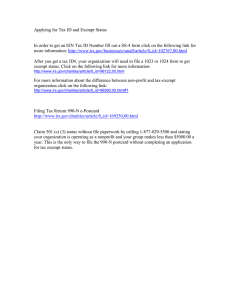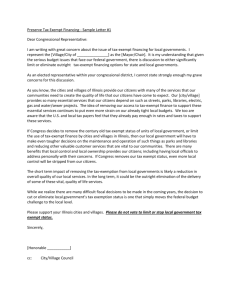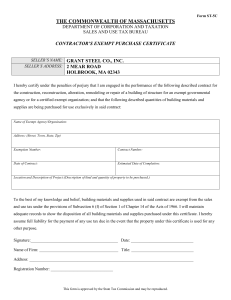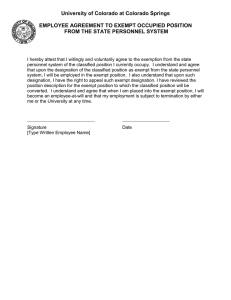Tax-Exempt Status p Session Objectives: j
advertisement
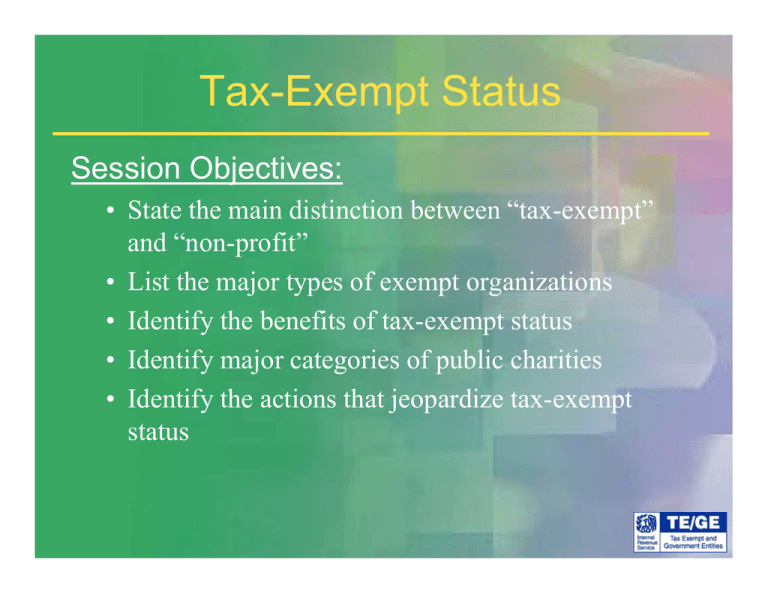
Tax-Exempt p Status Session Objectives: j • State the main distinction between “tax-exempt” and “non-profit” • List the major types of exempt organizations p status • Identifyy the benefits of tax-exempt • Identify major categories of public charities j p tax-exempt p • Identifyy the actions that jeopardize status What is an Exempt p Organization? g An exempt p organization g is: • A trust trust, association association, or corporation not organized for profit (i.e., nonprofit) that is described in the Internal Revenue Code as exempt p from Federal Income Tax. Types yp of Exempt p Organizations g Charitable § 501(c)(3) ( )( ) Schools,, churches,, foundations, etc Civic/Social Welfare § 504(c)(4) Rotary clubs Labor/Agricultural § 501(c)(5) AFL-CIO Business Leagues/ P f i l Professional § 501(c)(6) Chambers of Commerce, ABA AICPA ABA, Social Clubs § 501(c)(7) Country clubs, swim clubs Benefits of 501(c)(3) ( )( ) Status • Exempt from federal income tax and some federal employment taxes • E Exemptt from f some state t t taxes t (e.g., ( income, i sales, l employment) • Tax-deductible contributions • Tax-exempt financing • Reduced postal rates §501(c)(3) § ( )( ) - Three Prong g Test Must be organized and operated for an exempt purpose. Organizational g Test Organizing g g document must: • Limit purpose as stated in 501(c)(3) ( )( ) ppurposes p upon p • Distribute assets for 501(c)(3) dissolution • Not allow more than an insubstantial amount of non-exempt activity Examples of organizing documents: Articles of Incorporation, Trust documents, Articles of Association, Constitution Public Charityy v. Private Foundation Publicly supported (e.g., United Way) Not taxed on income Community-based C i b d board of directors Privately supported (e (e.g., g family or corporate foundations) Not taxed on income; may be subject to excise taxes F il or corporate board Family b d of directors Jeopardizing p g § 501(c)(3) ( )( ) Status • Inurement/private p benefit f activities prohibited and restricted • Lobbying activities must be insubstantial • Political activities are absolutely prohibited • Unrelated business activities must not be primary purpose Inurement/Private Benefit • Inurement to insiders such as ministers, church board members, officers, employees, etc., is absolutely prohibited. • Private benefit must be incidental to either i id or outsiders. insiders t id Lobbying y g Attempting p g to influence legislation g Measurement methods: • “Substantial Part” test - violation results in excise tax and revocation of exemption, • “Expenditure” test - violation results in excise tax and/or revocation of exemption Must make election on Form 5768. Churches cannot make k this thi election. l ti Political Activity y Direct and indirect candidate support: pp • Contributions • Participation in campaigns • Public statements for/against a particular candidate Absolute Prohibition! Unrelated Business Income • Trade or business activity • Regularly carried on • Not substantially related to organization’s exempt purpose For More Information Specialized Assistance on Tax-Exempt Organizations through the Exempt g (EO) ( ) division of the IRS: Organizations IRS Web site: www.irs.gov/charities Stay Exempt Online Workshop: www.stayexempt.org TE/GE Customer Account Services: (877) 829-5500 Internal Revenue Service TE/GE Customer Account Services P O Box 2508 P.O. Cincinnati, OH 45201 Subscribe to EO Update: • eoupdate@subscribe@lists.qai.irs.gov IRS tax forms and publications specific to charities are available on the EO website
